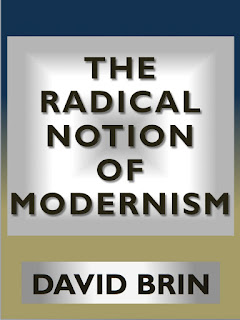Now you liberals should be warned. After laying into neoconservatives for quite some time, it is time to show faults on the other side. The Left-Right political axis has been a chief tool that romantic anti-modernists use to distract us from the real struggle.
Between future and past.
Part 10. Modernism gets a bad rap from the Left.
The irony is that everybody wants to accept the fruits of the LAST generation's modernist endeavors, while romantics of both left and right want to prevent anything new. I mean, would even the neocons want to go back to segregation? Would the most anti-tech lefty give up cell phones and recent medical advances? And who could complain about that music? All that incredible music.
Still, it is not the fruits of modernity that upset romantics. It is the conceptual underpinnings. The whole personality that they find offensive.
Counter-reaction had already set in before the can-do Congress of 1964 went cold. There had always been romantics on both the left and right who hated modernism. They found justification in Vietnam and urban riots. In Three Mile Island and the Exxon Valdez, and a long list of costly errors.
Make no mistake, it was a good thing to extend this trend to gays, the handicapped and even to Wiccan tree-worshippers. But along the way it became less and less about equalizing basic opportunity and ever-more about creating and stoking a movement. A movement that came equipped with ideologies, litmus tests, enemies lists, and long catalogues of forbidden words. Forbidden topics of conversation.
And forbidden technologies, forbidden projects, forbidden ideas. Former allies found themselves ejected from a liberalism that was fast becoming a dogmatic faith, led by an elite priesthood.
First to go were spaceflight and nuclear power, though both had done wonders for the planet and its people.
Then the military, although its desegregation under Harry Truman and George Marshall had been the event that gave civil rights irresistible momentum.
Then polite dissent became a crime within a thousand academic departments that veered toward doctrinal purity, purging any unacceptable deviation.
Next to be ejected from an ever-narrowing liberalism were the nation’s churches, forgetting how men and women of faith had helped to combat slavery, then to promote civil rights, then to resist the moral error of Vietnam. (Thus, they reject one of the greatest modernists of all, Martin Luther King.) And with the churches banished, so were traditional notions of parental guidance during childhood. Finally, that quintessential hippie, Jesus, got the boot from a movement that he probably would have helped to establish, at Woodstock.
Liberalism began reflexively assuming that everything white, rural or suburban, bourgeois, American, or socially demure was automatically suspect, until people with those traits began responding with hostility of their own. The very word “liberal” became a weapon in the hands of its enemies. And when this happened, the movement’s elites only made things worse by diagnosing that the common citizens had been brainwashed by propaganda. Contempt for the masses, invigorating and satisfying, thereupon displayed its deadly side-effect -- political suicide.
(Contempt is ultimately lethal, once the voting masses find out how you feel. We can hope this will be the comeuppance of the haughty neocons, before they do too much more harm.)
But the biggest break was between liberalism and modernism. Every ill-conceived or ill-executed error of the ambitious modernists came under scrutiny. Not for its pragmatic success-failure ratio, but for whether it met the Left’s growing catalogue of litmus standards. Engineers became reviled enemies. The very nerds and technologists who had been at the core of liberal-modernism’s can-do spirit were progressively alienated, until you can hardly find one who will even talk to a liberal anymore.
...on to part 11...
or return to Part 1: The Radical Notion of Modernism






